Is It Really Orphaned?
The most important question is: Does this animal REALLY need my help?
Around 50% of all animals that rehabilitators receive are animals that did not need to be rescued. Please be sure to read more on this page before handling the animal in question.
Many well-meaning people rescue an orphaned animal that does not need to be rescued. Animals make terrific mothers and their babies are always better kept with them versus humans.
DO NOT rescue wildlife and then KEEP (kidnap) the animal to care for it or keep it for a possible pet. State and federal laws protect nearly all wild mammals and birds. It is against the law to possess the animal or bird or the nests, feathers, or eggs of a bird without special permits. High fines and possible jail time are often given. In addition, dietary needs of each species of animal are different and it is almost impossible to duplicate their needs in captivity without special training. They might be cute, but they belong in the wild.
Second Chances receives many irreparably damaged birds and animals because the rescuer tried to keep it as a pet and did not know how to provide for it properly.
Animals carry diseases and parasites that can be transmitted for animals to humans. Some parasites can even cause brain damage to humans as well as death. The animal may look healthy, but can still carry these diseases and parasites. If you have cared enough to help an animal, please care enough to take the last step in saving it by contacting a trained wildlife rehabilitator that has the supplies needed to continue caring for this animal so it can one day be released back into its natural home. Even a day or two without proper care can make a life or death difference in some animals.
It is NOT true that mammals or birds will always reject their young once they have been handled by humans. Nonetheless, the handling of wild babies should be avoided or kept to a minimum. Handling by humans can be stressful to the animal. Also, the human scent can sometimes attract predators seeking food. Never pick up any wild animal/bird with your bare hands. Please note that only adults should handle a wild animal. Animals also can carry diseases and parasites that can transfer from the animal to humans. Wear gloves and use a stick, broom or rolled up newspaper to push the animal into an open paper bag or box. DO NOT put the animal into a plastic bag. Secure the top with tape so it doesn’t get out. BE CAREFUL! An animal that is hurt or frightened may bite. A towel or blanket may be thrown over the animal to catch it before putting it in a box.
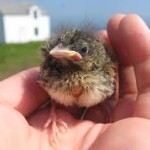
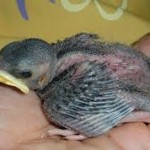 BIRDS are on the ground learning to fly. This is called fledging. Some bird species such as robins and blue jays remain on the ground for weeks. These birds look clumsy and injured. Unless you see a visible injury, please leave the fledglings to learn on their own. Mothers are often close by. Cats and dogs are the fledgling’s worry. Please keep your cat or dog indoors during this time. If you see a fledgling on the street, gently place it under a bush in a cat or dog free area. Birds that have fallen out of the nest can be placed back in. These birds will have little or no feathers. If the nest is destroyed, then make a nest from a Tupperware type bowl with paper towel inside and vent holes. Place the “nest” back in the tree.
BIRDS are on the ground learning to fly. This is called fledging. Some bird species such as robins and blue jays remain on the ground for weeks. These birds look clumsy and injured. Unless you see a visible injury, please leave the fledglings to learn on their own. Mothers are often close by. Cats and dogs are the fledgling’s worry. Please keep your cat or dog indoors during this time. If you see a fledgling on the street, gently place it under a bush in a cat or dog free area. Birds that have fallen out of the nest can be placed back in. These birds will have little or no feathers. If the nest is destroyed, then make a nest from a Tupperware type bowl with paper towel inside and vent holes. Place the “nest” back in the tree.
OPOSSUMS that are not injured and are over 7-8 inches long (not including tail) should be left alone. If they are less than 7-8 inches, please do not try to feed them as they do not have the ‘suckle” response and need to be tube fed VERY select formula. Opossums are prone to Metabolic Bone Disease due to diets. This can be fatal. ** If you should find a mother that is dead or hit by a car, check her pouch as more than likely, her babies are alive in there. They will need your help in order to live. FYI, opossums do not carry rabies as their body temperature is too low to harbor the disease. Opossum are great to have around as they eat rotten fruit, snakes, roaches, ticks, and mice. They keep to themselves.
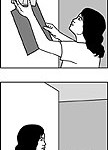 BATS If a bat is indoors, it is most likely a cave dwelling bat. Do not try to catch a flying bat. If one is in your house, close off the room, partially open a window, and in the evening , it should fly out. If you can not let it go through an open window or door, at least wait until it lands. Using a thick piece of paper, slide the paper under the bat as if gently “scraping” it off the wall. Do this while covering the bat with a shoebox. When the bat is in the box, put the paper on top as a lid. Remove paper in the evening and watch bat fly out. If the bat does not fly out or has trouble flying, call a rehabilitator. For reddish colored bats found outside, it’s probably a tree dwelling bat. Using a stick, gently touch the bat’s feet and it should cling to it. Place bat on the highest limb you can safely reach with a ladder. If the bat panics when you touch it’s feet, call a rehabilitator. Never pick up a bat, or any wild animal, with bare hands. The chance of rabies is extremely low (less than 1/2 of 1% of bats even have rabies), but always use caution. BE CAREFUL getting rid of bats. Some are federally endangered and against the law to remove. With the prevalence of Whit Nose Syndrome (WNS) bats are dying at an alarming rate. We need to do whatever we can to save every bat! Never extract bats during May-August as they have babies. Winter is the best to “bat-proof” your house. Need a bat house? Check out our store for tried and true working bat houses (with directions for use) handcrafted right here at Second Chances! If you need to contain a bat, watch a “how-to” video. Bats falling out of your bat box or vent? You need to build a bat pup catcher.
BATS If a bat is indoors, it is most likely a cave dwelling bat. Do not try to catch a flying bat. If one is in your house, close off the room, partially open a window, and in the evening , it should fly out. If you can not let it go through an open window or door, at least wait until it lands. Using a thick piece of paper, slide the paper under the bat as if gently “scraping” it off the wall. Do this while covering the bat with a shoebox. When the bat is in the box, put the paper on top as a lid. Remove paper in the evening and watch bat fly out. If the bat does not fly out or has trouble flying, call a rehabilitator. For reddish colored bats found outside, it’s probably a tree dwelling bat. Using a stick, gently touch the bat’s feet and it should cling to it. Place bat on the highest limb you can safely reach with a ladder. If the bat panics when you touch it’s feet, call a rehabilitator. Never pick up a bat, or any wild animal, with bare hands. The chance of rabies is extremely low (less than 1/2 of 1% of bats even have rabies), but always use caution. BE CAREFUL getting rid of bats. Some are federally endangered and against the law to remove. With the prevalence of Whit Nose Syndrome (WNS) bats are dying at an alarming rate. We need to do whatever we can to save every bat! Never extract bats during May-August as they have babies. Winter is the best to “bat-proof” your house. Need a bat house? Check out our store for tried and true working bat houses (with directions for use) handcrafted right here at Second Chances! If you need to contain a bat, watch a “how-to” video. Bats falling out of your bat box or vent? You need to build a bat pup catcher.
DUCKLINGS stay in groups, so if you do not see a mother around within an hour or so, it needs rescuing.
RACCOON babies that are alone, but quiet and alert, are being cared for by mom. Babies that appear to be weak or injured or have been seen for more than a few hours crying, have probably lost their mother, since mother raccoons closely supervise their young and don’t let them out of their sight! You can put an upside down laundry basket over the baby (with a weight on top) and monitor for a few hours from a distance. (Moms will NOT retrieve babies while you are in the area.) Sometimes raccoon moms will wait until very late to retrieve her babies. Ask around to see if anyone in the neighborhood trapped an adult raccoon or saw one hit by a car. If you do not see the mother after a few hours of watching from indoors, contact a licensed wildlife rehabilitator near you for assistance.
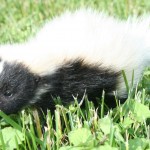 SKUNK babies do explore briefly at times away from its mother, yet it is more likely that the skunk has lost sight of the mother. Watch to see if the baby finds the den or if the mother retrieves him. You can put a plastic laundry basked upside down over the skunk to temporarily contain him while waiting for the mother to return. Approach the skunk slowly and talk softly – if the skunk gives a warning by stamping his front feet, then stand still or back off. You can approach again after the skunk calms down. As baby skunks get older, they sometimes come out to explore while the mother is away. Most of the time, however, they don’t appear without her – so if you repeatedly see the baby outside alone, he is likely orphaned. If the skunk appears to be truly orphaned, contact a licensed wildlife rehabilitator near you. Observation time for a single skunk is only about 30 minutes.
SKUNK babies do explore briefly at times away from its mother, yet it is more likely that the skunk has lost sight of the mother. Watch to see if the baby finds the den or if the mother retrieves him. You can put a plastic laundry basked upside down over the skunk to temporarily contain him while waiting for the mother to return. Approach the skunk slowly and talk softly – if the skunk gives a warning by stamping his front feet, then stand still or back off. You can approach again after the skunk calms down. As baby skunks get older, they sometimes come out to explore while the mother is away. Most of the time, however, they don’t appear without her – so if you repeatedly see the baby outside alone, he is likely orphaned. If the skunk appears to be truly orphaned, contact a licensed wildlife rehabilitator near you. Observation time for a single skunk is only about 30 minutes.
CHIPMUNKS that are consistently out of the burrow, are easy to catch, if there is no sign of mom, and/or if it is extremely thin, it needs rescuing. If you think mom is still around it is worth trying to reunite. She may come and then leave, but come back for it in a few hours. To reunite, leave the baby in the exact spot where found (mom won’t know to go look anywhere else). Leave in plain view and do not cover the animal with any materials; otherwise mom won’t be able to find it. Monitor from inside. Try only during daylight. If after several hours mom does not at least come to see the chipmunk then it rescuing.
SQUIRRELS are often not orphaned. Should you find a squirrel at night, it should be taken indoors (in box with heat pad on low UNDER HALF of the box, no food or water unless eyes open, then offer shallow jar lid of water and a few cheerios) for the night. You can try to reunite first thing in the morning. Squirrels often have a secondary nest if one should fall out of a tree. The mom should come back to retrieve her babies when she feels it’s safe. If you know mom is around, leave the area so she will feel safe to come back to get her babies. Observe from indooors. If you are not sure if mom is around, put baby in small box with an old t-shirt/piece of material with no loose threads, try to get off ground a bit, and watch from indoors to see if mom comes back within a few hours. Keep your pets inside so Mom will feel safe to get her baby. If she does not come back in 2-3 hours, this baby needs rescuing.
DEER will rarely be seen mother and baby together. Mom is only with her baby about 10 minutes per day…one feeding in the morning, one in the evening. Mom has a different nesting location. If you should see a fawn lying down without its’ mother, leave it there until morning and if it has not moved (even a foot or so), Mom may not be returning and please do call. If a baby is crying for hours continually, it needs help. You may not see mom during he day, but she is probably watching you. Stay away from baby so mom will feel safe to return. Keep pets away.
BUNNIES nests can be repaired. If you discover a nest, just place materials back over the burrow and leave it be. Skewer sticks, thin string can be placed in a tic tac toe formation over the top of the burrow. If they are moved the following morning, the mother has come back to take care of them. If not, they need your help. If bunnies are over 4 inches long, eyes open, and can hop, they do NOT need rescuing. Babies leave their nests just 10 day after their eyes open. Bunnies are rarely seen with their moms. Moms are only with their babies 5-10 minutes a day to quickly nurse them. Worried about for dog? Keep your dog on a leash for a few days to give the bunny time to move out on it’s own. It’s kind of a pain, I know, but it will save a life.
OTHER MAMMALS moms come and go. If the baby is wandering around crying for an hour, it needs your help. If you do not know, place in a box close to where you found it. If the mother does not come back in 4-6 hours, it needs help.
ALL ANIMALS will avoid coming to retrieve their babies if humans are around. Please watch for signs of mom without being too close or animals seeing you. Keep your pets inside while you wait!
If you deem that the animal truly does need rescuing, please call us immediately at 502-888-5470. The correct training, food, and supplies are waiting for this rescue animal. In the meanwhile:
Keep the baby or injured animal WARM and CONTAINED and QUIET. Put tissues or towels in the box or bag to keep it warm, and cover it. Darkness makes the animal feel more secure. Loud noises are scary, so keep that in mind when selecting a spot for the box. Keep it out of drafts and away from air conditioners. The box can be placed half on and half off a heating pad set on low. (Heat pad UNDER the box) If the animal gets too warm it can move to the other end of the box. A water bottle filled with warm water taped (to prevent rolling around) to the inside of the box will work just as well.
DO NOT FEED THE ANIMAL FOOD, WATER, OR MILK! Water and milk can go down into the animal’s lungs and kill it. Feeding an animal or bird the wrong food can cause severe diarrhea, dehydration, and even death. If an animal or bird has been caught by a cat or dog, please call Second Chances immediately. Even if wounds are not visible, the animal or bird needs to be given antibiotics.
Click here for a list of licensed Kentucky rehabbers.
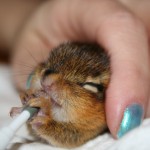 For each rescued animal brought to us, we do ask for a donation. Without donations, we can not provide care for the animals. While we’ll leave the amount up to you, below is the average cost it takes to raise one animal of its kind.
For each rescued animal brought to us, we do ask for a donation. Without donations, we can not provide care for the animals. While we’ll leave the amount up to you, below is the average cost it takes to raise one animal of its kind.
Raccoon- $350
Opossum- $250
Groundhog- $300
Squirrel/flying squirrel- $100
Bunny- $40
Skunk- $250
Bat- $75
Beaver- $1000
Fox/Coyote- $350
Mink- $200
Chipmunk- $75